Ultra-low cost airline Spirit Airlines has filed bankruptcy. The pioneer behind super low fares in the U.S. combined with fees for everything hasn’t had the product or route network that customers have wanted since the pandemic, has seen their labor costs rise significantly, and has faced a fleet with engine issues.
According to data from aviation analytics company Cirium, Spirit Airlines has an all-Airbusfleet of 213 planes, with 182 in service and 32 in storage. Their average age is 5.8 years.
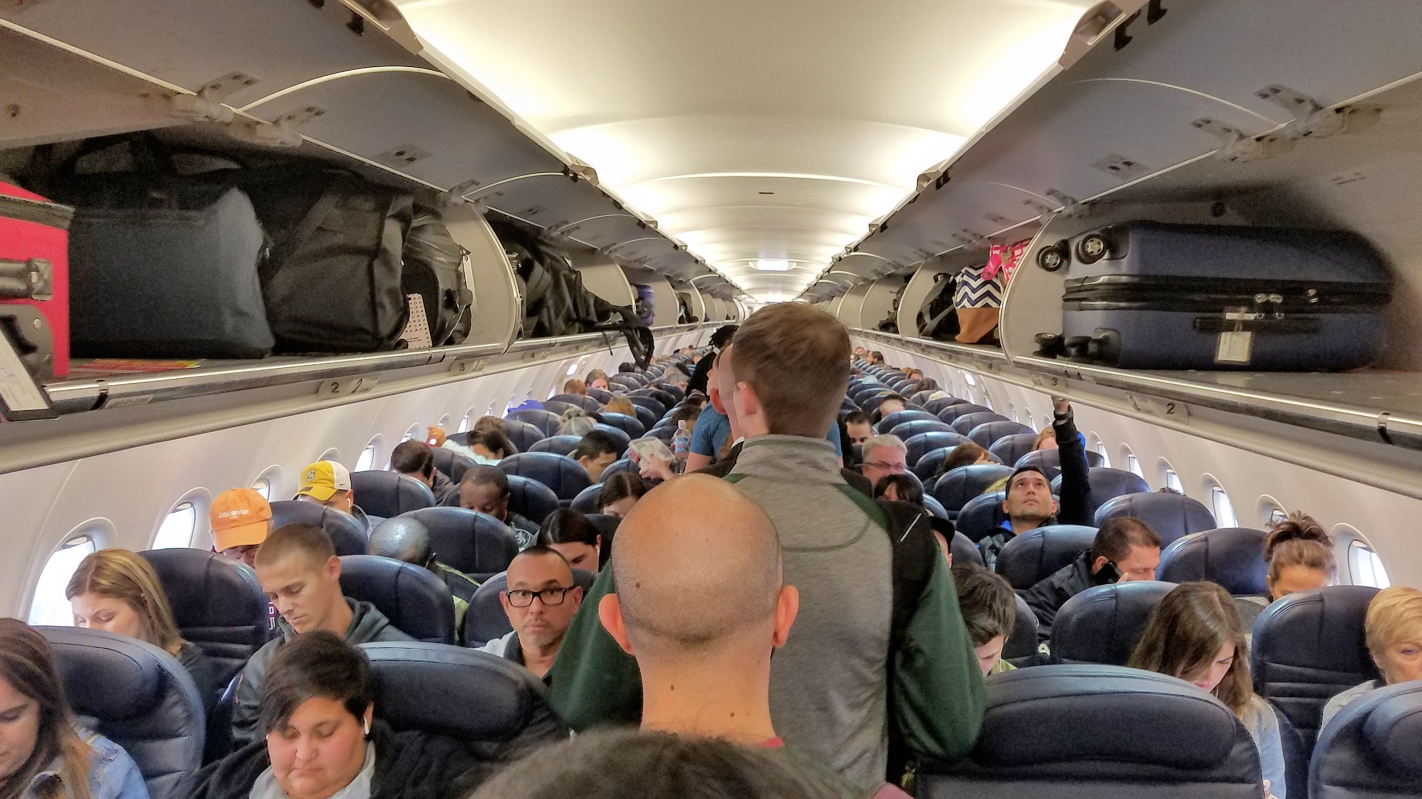
They have been severely affected by Pratt & Whitney’s geared turbofan engine issues. Currently 24 of their stored planes have these engines (which are on 55% of their fleet). In a recent earnings call Delta suggested that they were better-positioned for priority in dealing with such issues because of their size and importance as a customer.
Spirit saw an opportunity to sell themselves to Frontier Airlines, their main counterpart in low fares and high fees, but JetBlue came in offering a great deal more money. The Biden administration blocked that deal, believing it would reduce the amount of flying in the ultra-low cost carrier space. That’s the result we’re getting anyway.
With their bankruptcy filing, they’ve laid out the changes they believe are necessary to turn around the airline’s performance. And it’s taking further the notion that they need a different product to appeal to today’s consumers, especially in an environment of higher costs. They plan free wifi; free water and snacks for all; and improved customer service. They’re also planning improved upgrades for elite frequent flyers.
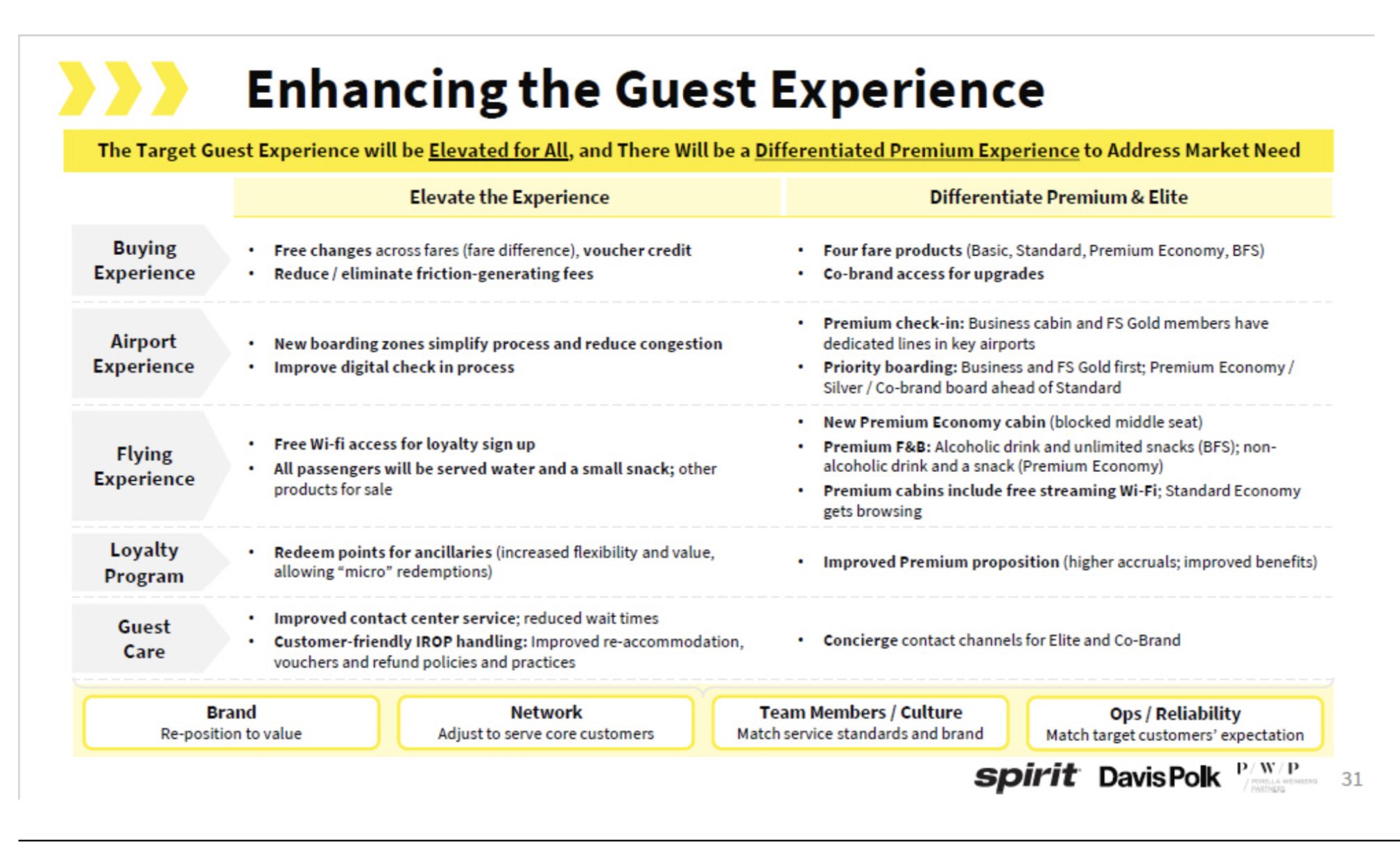
In the coming weeks they are planning loyalty program and credit card benefit changes, progress on their premium check-in, kiosk and bag drop airport experiences, and changes to their subscription Saver$ Club.

I’ve written that even though they’ve already dropped scores of routes, there will be more changes to their flying coming.
- We can expect to see more “less than daily” flying – so instead of a flight to a city every day, they’ll fly on peak travel days and won’t fly when they aren’t filling planes at sufficient fares.
- They’ll also alter their schedule for greater seasonality – again, flying when demand makes them profitable and eliminating flights at times of year that aren’t profitable.
- They’re said to be planning to do less flying out of major airline hubs where they face huge competition, and more flying from Fort Lauderdale.
- Spirit is following recent moves made by Frontier for more ‘out and back’ flying, which keeps flight cancellations and delays from spreading across their system.
- And, like Southwest, they’re planning to add airline partnerships. Spirit doesn’t fly long haul, and can’t take their customers to those places or sell tickets to them. They also don’t benefit from connecting traffic brought by airlines that do. This adds costs and complexity (such as interlining baggage), but focuses instead on revenue.
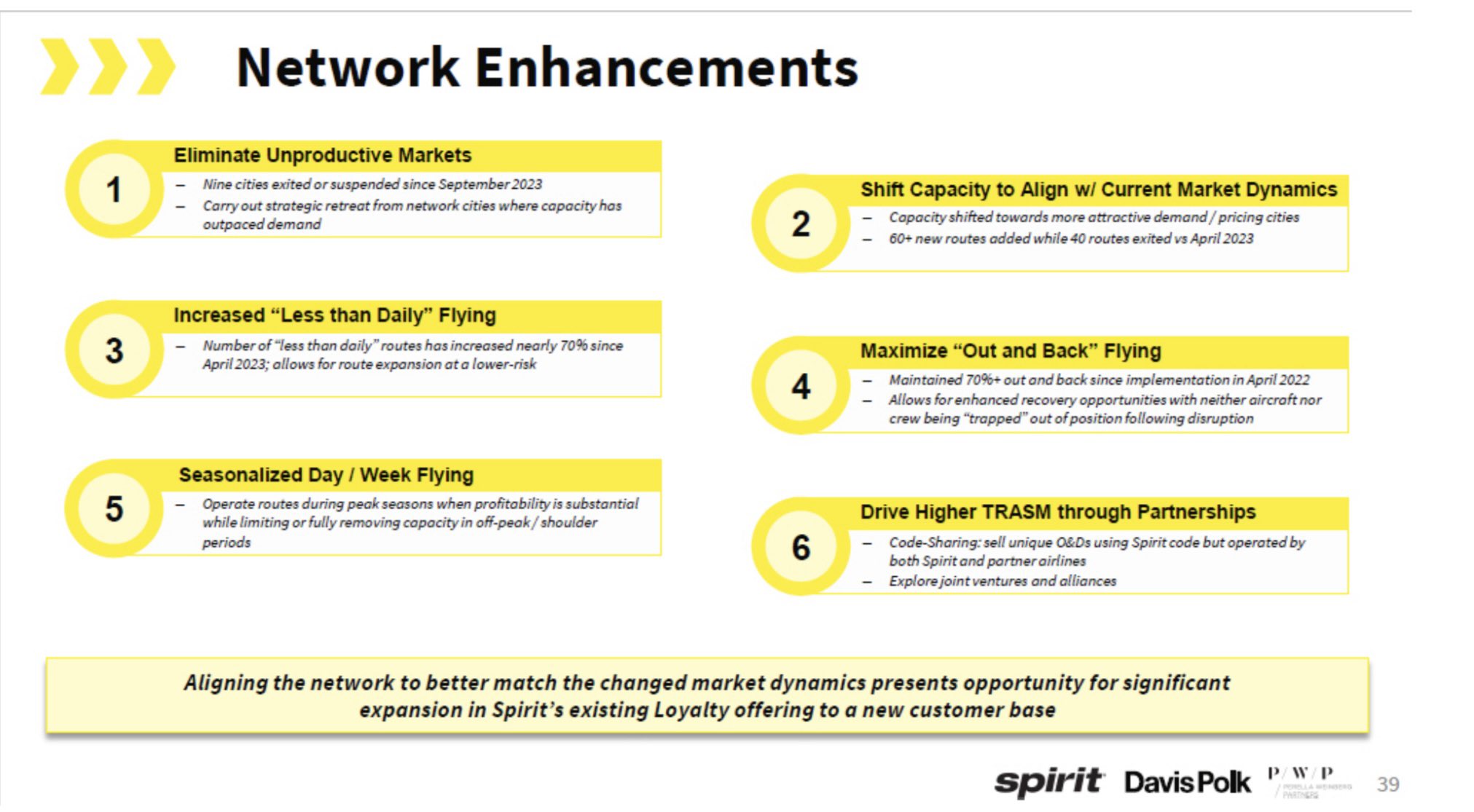
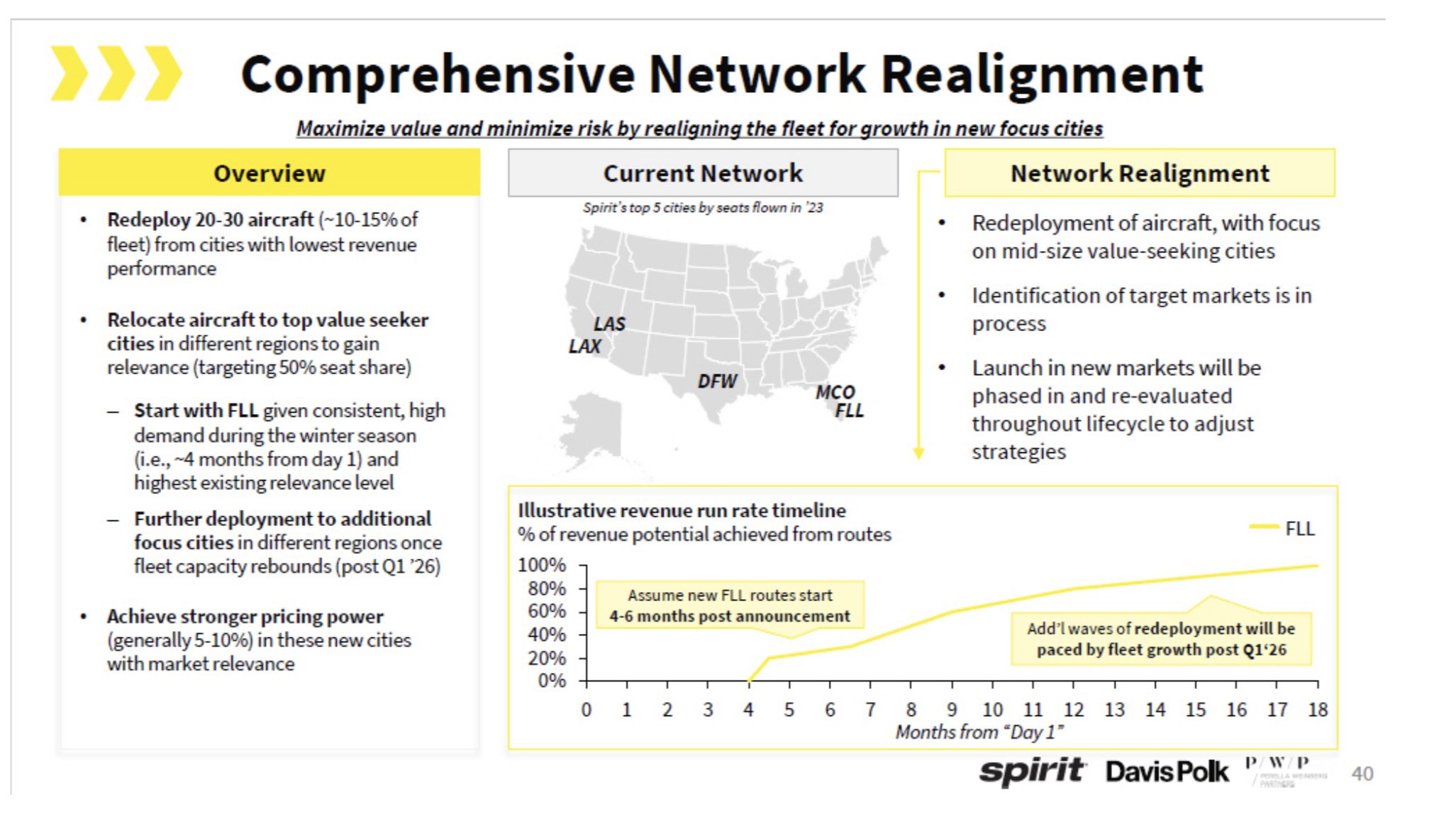
Spirit also wants to install seat power and larger overhead bins, as well as extra legroom coach seats.
The problem here is that Spirit’s model has been offering low fares at the lowest cost. Their costs are up, so they need to chase revenue. But they’re not going to be as good at that as Delta or United – because they offer neither the product nor the network. Taking a “me too” approach makes them at best JetBlue, which has underperformed the industry even with a significant head start.
It will be interesting to see how much of these changes that are part of the airline’s transformation plan actually come to pass. Another possible outcome is acquisition – perhaps, again, by Frontier. If that happened, we’d presumably see a less premium approach (Frontier doesn’t offer a domestic first class or wifi, for instance) and is doubling down on its low cost strategy rather than abandoning it.
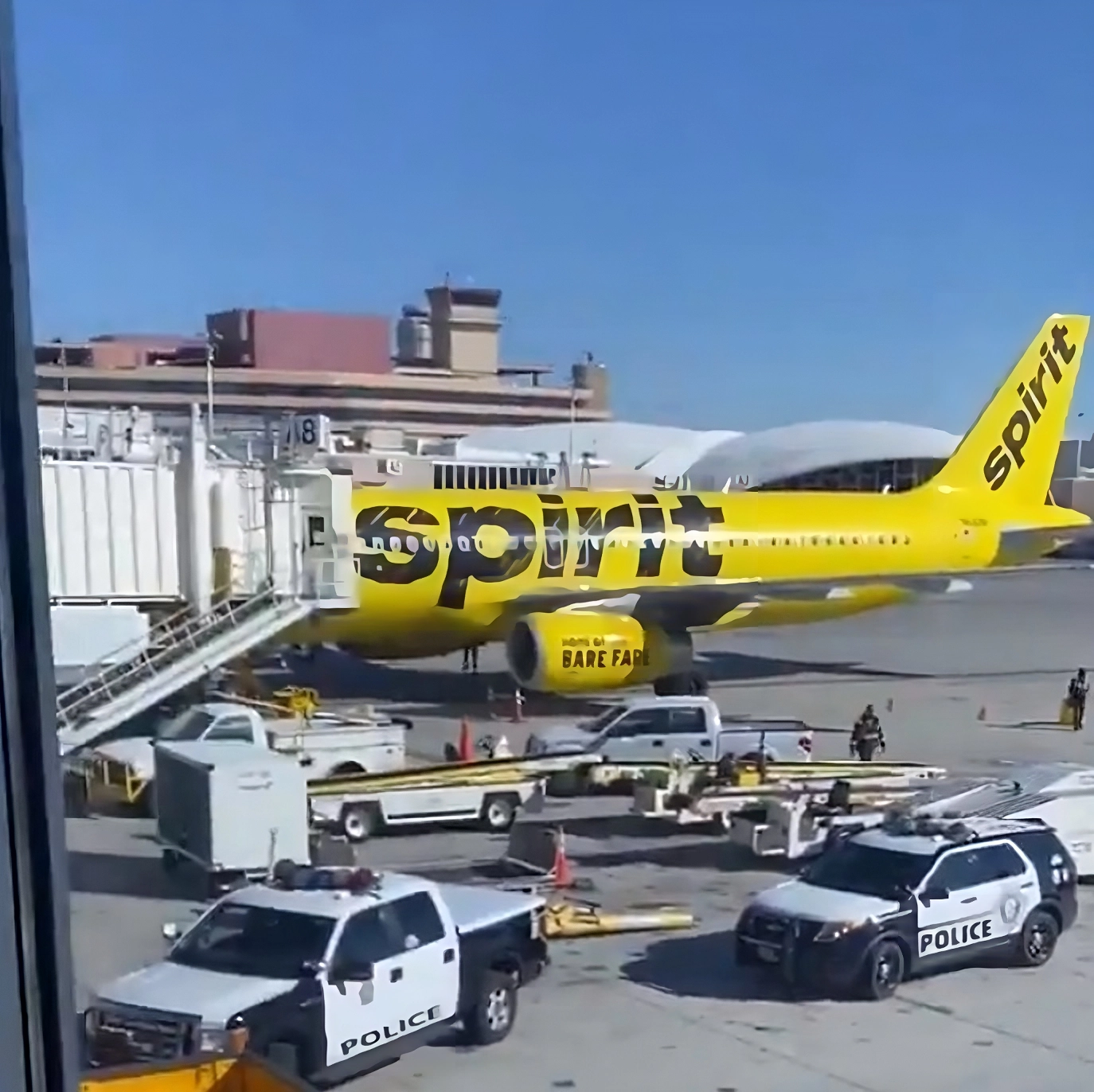
It’s unclear why talks between Spirit and Frontier broke down. Perhaps Spirit wanted something for shareholders, and all Frontier would do is something like ‘$1 and assumption of debt,’ or perhaps Frontier sees a better opportunity to acquire the assets in bankruptcy with bondholders taking a haircut.


Wow. Free Wifi and snacks for all when flying Spirit Airlines.
Will American Airlines need to file for bankrupcy before passengers are offered free wifi and snacks to all?
Have struggling ULCCs? Let’s have to bankrupt, because we don’t want less airlines. WTF logic is that?
when 6.6% of your planes can’t be flown, when you lose less money by parking 182 planes than flying them, when your way to profit is to only fly when you can bet the planes might be full, you file in Bankruptcy Chapter 11, Reorganization … unless some fool has given you massive post-filing funding to pay for Bankruptcy and operate till you’re again profitable … quickly move to Chapter 7, adios, come get your airplanes, our service items will be collectible some day … oopppss … we don’t have any service items ….
The question is can Spirit raise fares? Free wifi and snacks cost money and the ULCC business model is to cut costs to the bone and monetize everything possible save putting a coin machine on the lav doors. The biggest issue Spirit and Frontier have is the reputation they have developed via social media. YouTube is littered with Spirit and Frontier videos where a passenger melts down and has to be arrested by airport police. Sure that happens on other airlines but not at the same frequency. Sorry $39 fares bring out the bottom of the barrel, no matter how “un pc” that might sound.
Moreover, Spirit can’t survive on the $39 fare customer that doesn’t care if they get jammed into a middle seat in the next to last row. The only thing that they care about is the fare. They will stuff everything into a backpack. Pack a water bottle and fill it up at the airport. (I’ve even seen people fit it up at the bathroom sink.) Print their BP at home or use mobile if available. That consumer is certainly out there it just that an airline will never be profitable with that consumer.
First thing they need to do is get rid of all their hood employees and hire ppl that actually give 2 f*ks.
I hope they survive. I’d rather not have their customers on Delta, Southwest and American all of which I patronize.
The “less than daily“ flying is another big drawback. If the flight doesn’t operate, you have to wait more than one day for the next possible flight. More of that won’t help.
@George N Romey I dont mind the on aircraft experience of flying Frontier. When you pay McDonald’s prices, you don’t expect steakhouse quality. The issue I have is their frequent schedule changes and last minute cancellations. I have been burned a few times and the experience gets old quickly.
So they would become JetBlue Light… without the back seat screens and nice, soft seats. They would go from ULCC to LCC.
That would leave America with one MAJOR ULCC. If you live of the east or west coast, at least you have the slightly more expensive ULCC called Avelo if Spirit goes upscale. Limited network, but nice employees who don’t beat you up, extort you or curse you out.
The only way that I see Spirit rising from the ashes of bankruptcy is to “flush the employee/management toilet”. The front line employees are not very well vetted before hiring. They are obviously not well trained in their job, their demeanor with customers is below “whale doo doo” on the ocean floor. Management is at fault because they take their ultra low cost carrier status to mean, just get the jet from point A to point B and damned what the customers want/need. I say, let ’em sink. I’m guessing that if a Spirit employee applies to another airline, that airline will note where the prospective new hire comes from and say, “…eh NO!”.
when free WATER is an issue, it does not look good
Sad to see them liquidate but that appears to be the future. The rest of the Industry can grab the equipment, facilities, slots and whatever staff are worth saving and re-training.
Next up, AA & B6 merger the next Administration will approve
Several years ago when Spirit started significant flying out of major fortress hubs like DFW, ORD, ATL and MIA, I predicted that the Big Three airlines would not take kindly to this attempt at siphoning off some of their customers. Of course Spirit never had a chance at taking away any of their premium cabin or full-fare customers, and the customers they ended up with were ones that only fly when the fare is rock bottom, which the Big Three didn’t mind losing since they weren’t making money on those people anyway.
Even with 240 seats jammed into their A-321s and extra charges for everything, this doesn’t provide enough revenue to make these flights profitable. Frontier has found itself facing the same problems , and I believe this is why they have chosen not to attempt a merger with Spirit again. It would be a lot like when Sears bought Kmart – tying 2 sinking ships together won’t keep them both afloat, much less make them more prosperous.